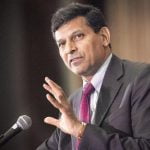 Raghuram Rajan said that the RBI will proceed in a calibrated way of eliminating the structural deficit. Photo: Aniruddha Chowdhury/Mint
Raghuram Rajan said that the RBI will proceed in a calibrated way of eliminating the structural deficit. Photo: Aniruddha Chowdhury/Mint
Mumbai: On Tuesday, Raghuram Rajan presented his last monetary policy announcement as the governor of the Reserve Bank of India (RBI). While Rajan maintained status quo on key policy rates in his policy, he also touched upon a number of things that concern India’s banking sector and monetary policy in the future.
Here are six points that Rajan discussed with reporters at the monetary policy announcement.
On Liquidity: The liquidity management framework announced in the April policy is being implemented. We have reduced some of the structural liquidity deficit, however, the current surplus is partly because of seasonal factors and not because we have eliminated the structural deficit completely. To emphasize this point, we announced an open market purchase today. The RBI will proceed in a calibrated way of eliminating the structural deficit. When we have done so, episodes of systemic surplus and systemic deficit should be evenly balanced.
Broadly speaking, we were at a deficit of about 1% of NDTL (net demand and time liabilities) and we are moving to eliminate that over time. The answer is, we are probably about 40% of the way at this point. There are seasonalities, like the government has also spent quite a bit and the tax revenues haven’t come back yet. The point is to not look at this as balance, because this is going to dissipate over time as the tax collections come in. The point is to have neutrality over the entire year.
Also Read: RBI keeps repo rate unchanged at 6.50%
On Transmission: Despite easy liquidity, banks have passed past rate cuts into lending rates only modestly. Earlier, some bankers had said that it was the lack of liquidity that was holding rates high, now I hear from some that it is the fear of FCNR (Foreign Currency Non-residental account) (B) redemption that is making them reluctant to cut rates. I have a suspicion that some new concern will crop up once the FCNR (B) redemption is behind us. We would be happy if there was more transmission. I do understand some of the difficulty that banks have. On our side, having examined our experience with the MCLR (marginal cost lending rate) framework, we will shortly be suggesting some revisions. However, substantial pass through will only happen when corporate credit demand picks up and as public sector banks, strengthened by clean balance sheets compete for corporate business.
On Bad loans: Broadly speaking, we are comfortable with the recognition process that banks have undertaken. Some banks have taken more steps that we required them to take. So the culture of cleaning up seems to be well embedded. As well as, the culture of recovery on some of the loans. What remains is for some of these large stressed projects to figure out a way to restructure them in a way that ensures the long term health of the system and the project. There are a number of RBI schemes available, the latest one being the S4A (scheme for sustainable structuring of stressed assets). Early days still. The attitude is also changing, the earlier attitude was that this is a way to postpone recognition. That is no longer there.
The question now is if this is a way to effect resolutions. The schemes are now being looked at with new eyes. The hope is that as the recovery in the economy also starts taking place, some of the stressed assets will be put back on track and there will also be more buying interest in some assets which have the possibility of new ownership. At this point, banks have enough tools, the real issue is to use them. I think we are working with them to ensure that we are working with them to ensure that any impediments are rectified. Again and again, we emphasize that we do not want to go back to the era of forbearance.
On FCNR (B): Let’s say the entire $26 billion (the amount that is estimated to be in FCNR (B) accounts across banks) goes out, we would have covered about 80% of it in forward markets and we have about $365 billion as of last count in our reserves. So even if it all goes out, we can completely pay for it. The real question is if there will be short term disruptions in the market, because say some banks who have sold us forward contracts find that they are not able to source dollars from elsewhere. We will be monitoring the markets. We do not want to give any blanket guarantee that there will be no volatility. We want banks to be prepared to deliver to us. But if there is volatility, we will do what is necessary.
On GST: It is not wise to assume that GST implementation will necessarily add to inflation. Whatever inflation happens, whether it will be long term or short term is something we need to think about. Even if there is inflation, it could be a one time adjustment of prices. What the monetary policy setters have to be worried about is whether this will pass to more generalized inflation and that is what the RBI will be worrying about, going forward.
On His Term: I have nothing to say, critics are there all the time. There are also people who send me anonymous messages in the plane saying thank you for what you are doing. So, you get both sides. I think the most important thing is that at the end of the day you feel that you have made a useful contribution and that some people are better off as a result of it. From that perspective, I think this has been a fantastic jump. I have enjoyed every minute of it, partly because everyday when my fellow colleagues at the RBI and I sit together and work, we manage to move the needle forward a little bit.
You leave the office saying, you did something and there are few places in the world where you can have that sense of satisfaction. So, I think this has been a fantastic experience and I hope there is some value added.
[“Source-Livemint”]




